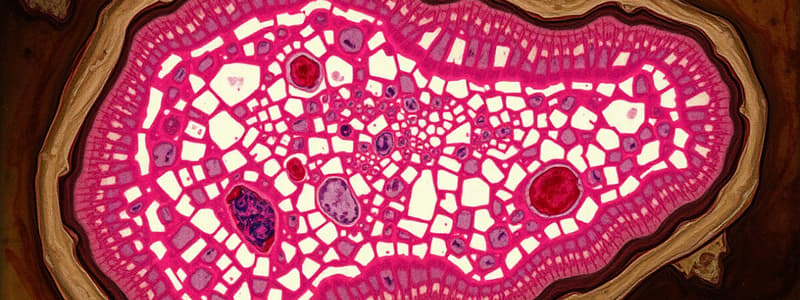Podcast
Questions and Answers
Which type of epithelial tissue is primarily involved in absorption and secretion?
Which type of epithelial tissue is primarily involved in absorption and secretion?
- Stratified squamous
- Stratified columnar
- Pseudostratified columnar (correct)
- Stratified cuboidal
What is the main function of stratified squamous epithelial tissue?
What is the main function of stratified squamous epithelial tissue?
- Secretion of hormones
- Facilitation of diffusion
- Protection against abrasion (correct)
- Transport of substances
Which characteristic is NOT associated with pseudostratified columnar epithelial tissue?
Which characteristic is NOT associated with pseudostratified columnar epithelial tissue?
- Flat, scale-like cells (correct)
- Unequal cell lengths
- Single layer
- Ciliated cells
What type of epithelial tissue is primarily found in the lining of the mouth and esophagus?
What type of epithelial tissue is primarily found in the lining of the mouth and esophagus?
Which of the following correctly describes the shape of cells in pseudostratified columnar epithelial tissue?
Which of the following correctly describes the shape of cells in pseudostratified columnar epithelial tissue?
What characteristic distinguishes simple cuboidal epithelial tissue?
What characteristic distinguishes simple cuboidal epithelial tissue?
Which type of epithelial tissue is characterized by its elongated cells and is often found in the gastrointestinal tract?
Which type of epithelial tissue is characterized by its elongated cells and is often found in the gastrointestinal tract?
What is a key function of stratified squamous epithelial tissue?
What is a key function of stratified squamous epithelial tissue?
How is pseudostratified columnar epithelial tissue different from other types of epithelial tissue?
How is pseudostratified columnar epithelial tissue different from other types of epithelial tissue?
Which of the following correctly identifies a function of simple squamous epithelial tissue?
Which of the following correctly identifies a function of simple squamous epithelial tissue?
Flashcards are hidden until you start studying
Study Notes
Epithelial Tissues
- Epithelial tissues can be classified based on the number of layers and cell shape: simple, stratified, cuboidal, columnar, squamous, and pseudostratified.
- Simple Squamous Epithelium: Single layer of flat cells; functions in absorption and secretion; found in linings of blood vessels and alveoli.
- Simple Cuboidal Epithelium: Single layer of cube-shaped cells; associated with absorption and secretion; observed in kidney tubules and glands.
- Simple Columnar Epithelium: Single layer of elongated cells; contains goblet cells for mucus secretion; located in the gastrointestinal tract.
- Pseudostratified Columnar Epithelium: Appears stratified due to varying cell heights but is actually a single layer; often ciliated; found lining the respiratory tract and involved in secretion and movement of mucus.
- Stratified Squamous Epithelium: Multiple layers of flat cells; provides protection against abrasion; located in the epidermis, mouth, and esophagus.
- Stratified Cuboidal Epithelium: Typically two layers of cube-shaped cells; involved in secretion; found in glandular ducts.
- Stratified Columnar Epithelium: Multiple layers with only the surface cells being columnar; functions in secretion and protection; found in some glands and male urethra.
Connective Tissues
- Composed of a diverse set of cells suspended in an extracellular matrix; functions include binding organs, providing support, and facilitating transport within the body.
- Acts as a protective barrier against pathogens through phagocytic activity, which engulf and digest invading microorganisms.
- Helps maintain body shape, conserve heat, and store energy in the form of adipose tissue.
Muscle Tissues
- Composed of muscle fibers that facilitate body movement, which can be voluntary (conscious control) or involuntary (unconscious control).
- Skeletal Muscle: Voluntary muscle attached to bones; striated and multinucleated; aids in movement and posture.
- Smooth Muscle: Found in the walls of hollow organs (e.g., intestines, bladder); involuntary, non-striated, and spindle-shaped cells; regulates the movement of substances through these organs.
- Cardiac Muscle: Found only in the heart; involuntary, striated, and possesses intercalated discs for synchronized contractions; essential for pumping blood.
Nervous Tissues
- Composed of neurons and supporting glial cells; functions in transmitting nerve impulses and supporting neural health.
- Astrocytes: Star-shaped cells that maintain the chemical environment around neurons; most abundant glial cell in the central nervous system (CNS).
- Microglial Cells: Ovoid cells that act as macrophages to clean neuronal debris and wastes; crucial for immune defense in the CNS.
- Ependymal Cells: Ciliated cells lining the central cavities of the brain and spinal cord; contribute to the production and circulation of cerebrospinal fluid, forming a barrier between CNS cavities and tissues.
Studying That Suits You
Use AI to generate personalized quizzes and flashcards to suit your learning preferences.



